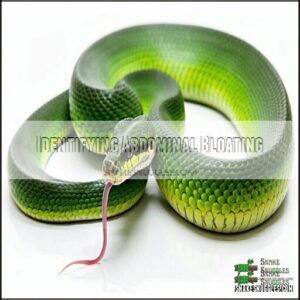This site is supported by our readers. We may earn a commission, at no cost to you, if you purchase through links.

Make sure your snake stays properly hydrated by providing fresh water and maintaining appropriate humidity in its enclosure. You can try a gentle belly massage, moving from head to tail.
Adjust feeding schedules—smaller, more frequent meals might help. Sometimes, adding a drop of mineral oil to prey items can act as a natural laxative.
If your snake hasn’t pooped in two weeks or appears distressed, it’s time for a vet visit. Proper prevention methods can save you both from this uncomfortable jam.
Table Of Contents
- Key Takeaways
- Snake Constipation Signs
- Treating Snake Constipation
- Causes of Constipation
- Home Remedies and Care
- Veterinary Intervention
- Frequently Asked Questions (FAQs)
- How to prevent constipation in snakes?
- What can I do to relieve constipation?
- Do Snakes get constipated?
- How do you know if a snake is constipated?
- How do you get rid of a snake poop?
- What happens if a snake doesn’t poop?
- How do you fix a constipated snake?
- How do you treat constipation in reptiles?
- Can certain snake species be more prone?
- Are there specific symptoms of intestinal blockage?
- Conclusion
Key Takeaways
- Soak your snake in warm water (85-90°F) for 15-30 minutes daily to relax its muscles and stimulate bowel movements.
- Keep your snake hydrated with fresh water and maintain proper humidity and temperature levels in the enclosure.
- Gently massage your snake’s belly from head to tail during soaks to ease constipation.
- If symptoms persist beyond two weeks, consult a vet immediately to prevent severe complications like impaction.
Snake Constipation Signs
You’ll need to watch for bloating, lethargy, and lack of appetite when your snake hasn’t pooped for two weeks after feeding.
Recognizing these warning signs early helps you take quick action before constipation develops into a more serious impaction that could harm your scaly friend.
Identifying Abdominal Bloating
Frequently, the first visible sign of snake constipation is abdominal bloating.
Here’s a short, engaging blockquote in the same tone:
Abdominal bloating is your first red flag that your snake’s digestive system has hit the brakes.
You’ll notice an unusual swelling or distension in your snake’s mid to lower body.
This bloating location typically appears 1-2 inches above the vent area.
When gently palpating your snake, the bloated section feels firm or hard.
The severity of bloating indicates how serious the digestive issues are, so monitor any changes closely, as this can be a sign of a more serious condition related to snake constipation.
Recognizing Lethargy and Loss of Appetite
Beyond abdominal swelling, your snake’s behavior offers vital clues about constipation. A healthy snake is regularly active and enthusiastic to eat, but constipation changes this dramatically.
Watch for these behavioral cues:
- Unusual lethargy or hiding more than normal
- Complete refusal of food or loss of interest in prey
- Markedly reduced activity, especially after meals
- Visible weight loss despite normal feeding schedule
These early warning signs of snake digestive issues warrant immediate attention. Lethargy and anorexia are, in fact, common indicators of illness, which can signal a serious underlying condition requiring prompt veterinary care to prevent further complications.
Monitoring Stool Production and Consistency
While lack of appetite signals trouble, your snake’s poop tells the full story.
Your snake’s stool reveals critical clues—monitor frequency, consistency, and color to catch constipation early and ensure digestive health.
Check defecation frequency—healthy snakes should eliminate within 5-7 days after feeding.
Examine snake feces for unusual stool color, abnormal smells, or undigested food.
Normal bowel movements should be well-formed with white urates present.
Dark, dry, or infrequent snake feces indicates constipation.
Keep a simple log of your snake’s bathroom habits to spot problems early and understand the bathroom habits.
Treating Snake Constipation
When treating snake constipation, quick action is essential to prevent more serious health issues. Your reptile friend depends on your prompt intervention to restore their digestive health.
- Warm water soaks (85-90°F) for 15-30 minutes daily stimulate bowel movements and hydrate your snake naturally
- Lubricant options like mineral oil can be administered orally or cloacally under vet supervision
- Fiber supplements added to food help move things along, but consult a snake vet first
- Fluid therapy might be necessary for dehydrated snakes, typically administered by a professional
For mild cases, gentle belly massages during warm water soaks can work wonders. Move your fingers in light, circular motions from head to tail. If there’s no improvement after a week of home treatment, professional help is vital.
Remember, surgical risks increase the longer constipation persists, so don’t delay seeking treatment. A key preventative measure is providing fresh water to avoid dehydration.
Causes of Constipation
Your snake’s constipation can stem from several common issues including dehydration, improper cage temperatures, substrate ingestion, or overfeeding.
Understanding these causes will help you spot potential problems early and take quick action to get your slithery companion’s digestive system moving again, which is crucial for addressing constipation.
Dehydration From Frozen-Thawed Food
Now that you understand how to treat constipation, let’s look at what causes it.
Frozen-thawed food can substantially reduce your snake’s water intake. When prey items are frozen, they lose water content that would naturally hydrate your snake’s digestive system.
This water loss makes feces harder and drier, leading to constipation. Some owners improve hydration using specialized hydration products.
Try injecting 10ml of water into thawed rats before feeding, or completely warm prey items in water to improve hydration and prevent digestive issues.
Low Temperatures and Humidity Levels
Your snake’s digestive system needs proper heat to work correctly.
Low temperatures slow digestion dramatically, causing food to sit in your snake’s gut for too long.
Without an ideal thermogradient (85-95°F for most species), constipation becomes likely.
Similarly, inadequate humidity levels lead to dehydration, making stools harder to pass.
Monitor humidity daily to prevent shedding issues and respiratory infections.
Remember, species requirements vary—ball pythons need different conditions than corn snakes.
A consistent heat source is essential.
Substrate Impaction From Sand or Gravel
Those tiny particles of sand and gravel in your snake’s enclosure can become trouble magnets.
When your pet hunts prey or burrows, it often ingests these particles accidentally. Sand Impaction Risks are serious – these materials absorb moisture, drying up feces and creating blockages.
Gravel Ingestion Dangers include complete obstruction of the digestive tract.
Switch to Safe Substrates like cypress mulch or paper towels to prevent substrate impaction and snake constipation. Many owners find cypress mulch effective for reptile enclosures.
Overfeeding and Obesity
Many snake owners don’t realize that overfeeding directly contributes to constipation.
When you feed your snake too much, it can quickly become obese, leading to reduced colon movement and difficulty passing waste.
Obesity risks include metabolic disorders and organ damage that shorten your pet’s lifespan.
Proper dietary management means feeding adult snakes just one appropriately-sized meal weekly, not whenever they seem hungry.
Overfeeding can also lead to digestive issues that exacerbate constipation.
Home Remedies and Care
You can treat your snake’s constipation at home with simple remedies that often work faster than you’d expect.
Warm water soaks, proper humidity levels, and gentle belly massages will help your scaly friend get things moving again without an expensive trip to the vet, using simple remedies and gentle methods.
Warm Water Soaks and Belly Massages
Now that you understand what causes your snake’s constipation, let’s get them moving again with warm water soaks and gentle belly massages.
Fill a container with warm water (85-90°F soak temperature) and place your snake in it for 15-30 minutes daily. The soak duration helps soften impacted material.
For an effective snake constipation remedy:
- Apply light massage pressure from head to tail
- Use circular motions during the belly massage
- Maintain consistent massage frequency (daily with soaks) to help your snake recover from impacted material.
Adjusting Temperature and Humidity Levels
Setting up proper temperature gradients is essential for treating snake constipation.
Your reptile’s digestive system simply won’t function at incorrect temperatures. Maintain a warm side (85-90°F) and cooler side (75-80°F) in the enclosure, adjusting for species requirements.
Equally important is humidity monitoring—most snakes need 50-70% humidity to prevent dehydration.
Use digital thermometers and hygrometers to track these conditions, making seasonal adjustments as needed.
Providing Fresh Water and Roughage
While ideal temperature and humidity create the right environment, hydration is your next focus.
Always provide clean, fresh water for your snake to prevent constipation. Defrost prey items in water before feeding to maximize hydration – soaking works better than spraying.
For stubborn cases of snake constipation, try adding dietary fiber through appropriate roughage sources. Remember, proper hydration methods directly impact how easily your scaly friend passes waste, and this is crucial for maintaining your snake’s overall health through effective hydration.
Gentle Abdominal Massage Techniques
While fresh water helps internally, physical intervention can directly address the blockage.
To perform an effective belly massage for snake constipation, gently cradle your pet after a warm water bath when muscles are relaxed.
Using light fingertip pressure, massage in a head-to-tail direction with small circular motions. Watch for resistance—if your snake tenses, pause immediately.
Employing gentle handling techniques can help minimize stress during this process.
Repeat this process daily until normal bowel movements resume, using gentle handling to ensure the snake’s comfort.
Veterinary Intervention
When home remedies don’t resolve your snake’s constipation, you’ll need to consult a reptile veterinarian who can perform diagnostic tests and provide medical treatments.
Professional care becomes necessary if your snake shows severe bloating, prolonged lethargy, or hasn’t defecated for several weeks despite your efforts, which may indicate a need for professional care.
Signs of Severe Constipation or Impaction
Recognizing when your snake needs emergency veterinary care can save its life.
Take your pet to a reptile specialist immediately if you notice these signs of severe constipation or impaction:
- Prolonged anorexia (refusing food for more than 2-3 weeks)
- Visible distress, including unusual posturing or restlessness
- Complete fecal absence for over three weeks
- Severe bloating with a palpable mass in the abdomen
Don’t wait until these snake digestive issues require surgical urgency.
Diagnostic Tests and Enemas
When your snake arrives at the veterinarian’s office, diagnostic tests will begin right away.
The vet will likely order radiographs to visualize blockages and assess severity. Fecal analysis helps identify underlying issues like parasites.
If necessary, your vet may administer an enema solution under sedation using a lubricated catheter. Imaging techniques like ultrasound might also be used before determining if fluid therapy or surgical necessity exists for treating your snake’s constipation.
Surgical Intervention for Impaction Removal
When all other options fail, your vet may recommend surgery for your snake’s impaction.
During this procedure, vets make a careful incision along the lateral scales to access the blockage.
They then isolate the affected area and remove the impacted material (fecalith extraction).
While surgical removal carries risks related to anesthesia protocols and potential recovery complications, it’s sometimes the only way to resolve severe bowel obstruction in snakes with persistent impaction.
Post-Operative Care and Recovery
In the aftermath of surgery, your snake needs special care to facilitate a smooth recovery. Focus on creating a healing environment with slightly increased temperature and humidity levels.
After surgical intervention for constipation, follow these key steps:
- Monitor the incision site daily for signs of infection
- Administer medications exactly as prescribed by your vet
- Withhold food for 5 days, then only offer water for 6 weeks
Limited handling during recovery prevents stress and aids healing.
Frequently Asked Questions (FAQs)
How to prevent constipation in snakes?
Think of prevention like setting up a cozy spa—keep your snake hydrated with fresh water, maintain proper temperature and humidity.
Avoid risky substrates, and monitor feeding, balance these, and your snake should stay regular, it’s all about proper care and maintaining the right balance.
What can I do to relieve constipation?
Start by soaking your snake in warm water (85-90°F) for 15-30 minutes daily.
Gently massage downward along its belly during soaks.
Adjust enclosure humidity and temperature, and offer fresh water to encourage hydration.
Do Snakes get constipated?
Yes, snakes can absolutely get constipated.
When poop piles up, they might seem bloated, sluggish, and even skip meals.
It’s often due to dehydration, poor temperatures, or swallowing something indigestible like substrate.
How do you know if a snake is constipated?
You’ll know your snake’s constipated if it hasn’t pooped two weeks after feeding, looks bloated, or stops eating.
Watch for straining during defecation attempts, lethargy, or dry, hard feces as additional signs.
How do you get rid of a snake poop?
To get rid of snake poop, gently clean it using gloves, paper towels, and a reptile-safe disinfectant.
Make sure to clean the entire area in the enclosure to prevent bacteria buildup and maintain hygiene.
What happens if a snake doesn’t poop?
If a snake doesn’t poop, it may become bloated, lethargic, or lose appetite.
Prolonged constipation can lead to impaction, a severe condition needing vet care.
Address it quickly to avoid serious health risks.
How do you fix a constipated snake?
Warm water soaks (85–90°F) for 15–30 minutes daily help stimulate bowel movements.
Massage the belly gently, and adjust enclosure humidity and temperature.
If constipation continues, consult a reptile vet to prevent serious issues.
How do you treat constipation in reptiles?
Over 40% of reptile constipation cases stem from dehydration.
Soak your reptile in warm water for 15 minutes daily, massage its abdomen gently.
Make certain proper enclosure temperatures, humidity, and clean drinking water to promote digestion.
Can certain snake species be more prone?
Certain snake species, like ball pythons and boas, might be more prone to constipation due to their size, diet preferences, or temperature needs.
Keep their habitat just right to help avoid digestion troubles.
Are there specific symptoms of intestinal blockage?
When something’s off, look for bloating, lethargy, and a refusal to eat.
Straining during bowel movements, dry feces, and distended belly loops are red flags.
Trust your gut—don’t ignore these signs of intestinal blockage!
Conclusion
Did you know snakes can go weeks without pooping, but two weeks of constipation signals a bigger issue?
Knowing how to treat snake constipation will keep your pet comfortable and healthy.
Start with warm soaks, hydration, and gentle massages. Adjusting diet and enclosure conditions can prevent future issues.
If symptoms persist or worsen, a vet can provide advanced care. By acting quickly and maintaining proper husbandry, you’ll help your scaly friend thrive and stay regular.












